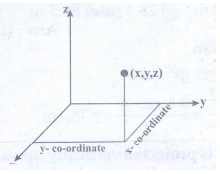Kinematics | Physics - Short Questions and Answer | 11th Physics : UNIT 2 : Kinematics
Chapter: 11th Physics : UNIT 2 : Kinematics
Short Questions and Answer
Kinematics | Physics
Short Answer Questions
1. Explain what is meant by Cartesian coordinate system?

At
any given instant of time, the frame of reference with respect to which the
position of the object described interms of position co-ordinates (x, y, z) is
called Cartesian Co-ordinate system.
2. Define a vector. Give examples
The
physical quantity which is described by both magnitude and direction are called
vector. Examples : Force, Velocity, Displacement, Acceleration.
3. Define a scalar. Give examples
The
physical quantity which is described only by magnitude are called scalar.
Examples
: Distance, Mass, Time, Speed.
4. Write a short note on the scalar product between two vectors.
The
scalar product (or) dot product of two vectors is defined as the product of the
magnitude of both the vectors and the cosine of the angle between them.

5. Write a short note on vector product between two vectors.
The
vector product (or) cross product of two vectors is defined as another vectors
having a magnitude equal to the product of the magnitude of two vectors and the
sine of the angle between them.

6. How do you deduce that two vectors are perpendicular?
(i)
The scalar product of two vectors ![]() .
.![]() then these two vectors are
perpendicular to each other because cos 90° = 0, then
then these two vectors are
perpendicular to each other because cos 90° = 0, then
![]() .
. ![]() = AB cos θ = AB cos90° = 0.
= AB cos θ = AB cos90° = 0.
Then
the vectors ![]() and
and ![]() are said to be mutually orthogonal.
are said to be mutually orthogonal.
(ii)
The vector product of two vectors will have maximum magnitude when sin 90° = 1
i.e.
θ = 90° then  then the vectors
then the vectors ![]() and
and ![]() are orthogonal to each other.
are orthogonal to each other.
7. Define displacement and distance.
Distance : Distance
is the actual path length travelled by an object in the given interval of time.
Displacement :
Displacement is the difference between the final and initial positions of the
object in a given interval of time.
8. Define velocity and speed.
Velocity: Velocity
is equal to rate of change of position vector with respect to time.
Velocity
is a vector quantity, 
Speed: The speed
is defined as the ratio of total path length travelled by the particle in a
time interval. It is a scalar quantity.
Speed
= Path length / Time
9. Define acceleration.
●
The acceleration of the particle at an instant is equal to rate of change of Velocity.
●
Acceleration is a vector quantity. Its SI unit is ms-2 and its
dimentional formula is 
10. What is the difference between velocity and average velocity.

Velocity
1.
Velocity is equal to rate of change of position vector with respect to time.
2. It tells about the direction of motion of the particle.
Average Velocity
1.
The average velocity is defined as rate of the displacement vector to the
corresponding time interval.
2. The direction of average velocity is in the direction of displacement vector
11. Define a radian?
One
radian is the angle substended at the center of a circle by an arc that is
equal in length to the radius of the circle.
1
rad ≅ 57.295° (or) 1 rad = 180 / π degree
12. Define angular displacement and angular velocity.
i)
Angular displacement: The angle described by particle about the axis,
of rotation in a given time is called angular displacement. The unit of angular
displacement is radian. Angular displacement θ = s / r
ii)
Angular Velocity : The rate of change of angular displacement is
called angular velocity.
The
unit of angular velocity is radian per second Angular Velocity ω = dθ / dt
13. What is non uniform circular motion?
The
velocity changes in both speed and direction during the circular motion is
called non - uniform circular motion.
14. Write down the kinematic equations for angular motion.
i)
ω = ω0 + α t
ii)
θ = ω0 t + ½ α t2
iii)
ω2 = ω02 + 2αθ
iv)
θ = [ (ω0+ω)t
] / 2
15. Write down the expression for angle made by resultant acceleration and radius vector in the non uniform circular motion.
Centripetal
acceleration = v2 / r
Magnitude
of resultant acceleration
aR
= √ [ at2 + (v2/r)2 ]

The
resultant acceleration makes an angle θ with radius vector
The
angle is given by tan θ = at / (v2 / r)
Related Topics